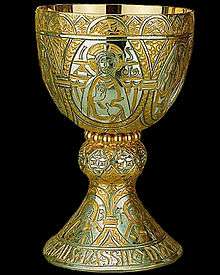Tassilo III, Duke of Bavaria
Tassilo III (c. 741 – c. 796) was the duke of Bavaria from 748 to 788, the last of the house of the Agilolfings.

Tassilo, then still a child, began his rule as a Frankish ward under the tutelage of his uncle,[1] the Carolingian Mayor of the Palace Pepin the Short (later king) after Tassilo's father, Duke Odilo of Bavaria, had died in 748 and Pepin’s half-brother Grifo had tried to seize the duchy for himself. Pepin removed Grifo and installed the young Tassilo as duke, but under Frankish overlordship.
Then, in 757, according to the Royal Frankish Annals, Tassilo became Pepin’s vassal and the lord for his lands at an assembly held at Compiegne. There, he is reported to have sworn numerous oaths to Pepin and, according to reports that may have been written much later, promised fealty to him and his sons, Charles and Carloman.[2] However, the highly legalistic account is quite out of character for the period. K. L. Pearson has suggested[3] that it probably represents a reworking of the original document by the annalist to emphasise Charlemagne's overlordship over Tassilo during the period of hostilities between the two rulers.
Around 760, Tassilo married Liutperga, daughter of the Lombard king, Desiderius, continuing a tradition of Lombardo-Bavarian connections. He made several journeys to Italy to visit his father in law and to establish political relations with the pope. It is reported that Tassilo had gained such a reputation that he was regarded as a kingly ruler when his cousins Charles and Carloman assumed power in the Frankish realm in 768.[1] That year, he founded Gars Abbey on the Inn River, in southern Bavaria.[4] He was, however, not able to protect the pope against Lombard expansions, which has been seen as a reason for Rome's lack of support for him during his later conflict with Charlemagne. Still, there is a consensus among historians that Tassilo, despite acting as a kingly sovereign, did not intend to become king himself.[1]
Tassilo nevertheless undertook such kingly duties as founding Kremsmünster Abbey. According to legend, Tassilo discovered the body of his son, Gunther, who had been attacked by a wild boar during a hunt. In grief, he founded the monastery on the site in 777.
In 763 Tassilo was accused by the Franks of defaulting on his military obligations to Pepin, leaving the Frankish campaign in Aquitaine on grounds of ill health. Pearson suggests that he left because he felt an obligation to the Aquitanians in light of an earlier alliance, made between Tassilo’s father and the Aquitanian duke during his conflict with Pepin in 743. Whatever the motivations behind Tassilo's abandonment of the campaign, the Royal Frankish Annals for that year are particularly scathing of him, saying that he "brushed aside his oaths and all his promises and sneaked away on a wicked pretext". Working on the premise that the annals may have been revised to emphasise Tassilo as a vassal, Pearson suggests that to be the beginning of a campaign to depict Tassilo as an oath-breaker and someone unprepared to carry out the main function of his office, to fight, which would make him unfit for rule.
The incident was the linchpin in Charlemagne and Pope Adrian I's argument that Tassilo was not an independent prince but a rebellious vassal, deserving punishment.[5] The punishment was carried out, after much political maneuvering, during a diet in the Imperial Palace Ingelheim in 788, when Tassilo was finally deposed and then entered a monastery.[6] In 794, Tassilo was again compelled, at the synod of Frankfurt, to renounce his and his family's claims to Bavaria. He formally handed over to the king all of the rights that he had held. [7]
Notes
| Wikimedia Commons has media related to Tassilo III, Duke of Bavaria. |
- Jahn, Wolfgang (2012). "Der Herzog und der König [The Duke and the King]". Damals (in German). Vol. 44 no. 4. pp. 16–23.
- Moore, Michael Edward (2011-11-07). A Sacred Kingdom: Bishops and the Rise of Frankish Kingship, 300-850. ISBN 9780813218779.
- Kathy Lynne Roper Pearson, Conflicting Loyalties in Early Medieval Bavaria: a View of Socio-Political Interaction, 680–900. (Aldershot: Ashgate), 1999.
- "Geschichte". Kloster Gars. Retrieved 2013-12-08.
- Goldberg, Eric Joseph (2006). Struggle for Empire: Kingship and Conflict Under Louis the German, 817-876. ISBN 9780801438905.
- Goldberg, Eric Joseph (2006). Struggle for Empire: Kingship and Conflict Under Louis the German, 817-876. ISBN 9780801438905.
- Collins, Roger (January 1998). Charlemagne. ISBN 9780802082183.
| Preceded by Odilo |
Duke of Bavaria 748–788 |
Succeeded by Charlemagne |